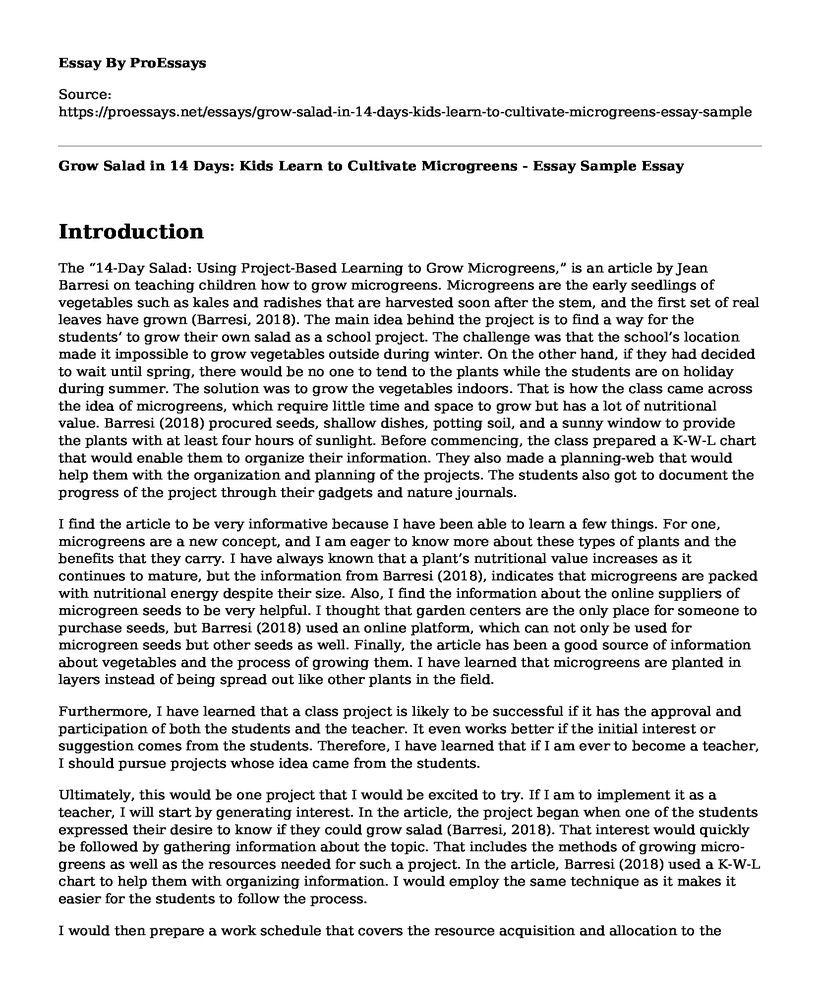Introduction
The “14-Day Salad: Using Project-Based Learning to Grow Microgreens,” is an article by Jean Barresi on teaching children how to grow microgreens. Microgreens are the early seedlings of vegetables such as kales and radishes that are harvested soon after the stem, and the first set of real leaves have grown (Barresi, 2018). The main idea behind the project is to find a way for the students’ to grow their own salad as a school project. The challenge was that the school’s location made it impossible to grow vegetables outside during winter. On the other hand, if they had decided to wait until spring, there would be no one to tend to the plants while the students are on holiday during summer. The solution was to grow the vegetables indoors. That is how the class came across the idea of microgreens, which require little time and space to grow but has a lot of nutritional value. Barresi (2018) procured seeds, shallow dishes, potting soil, and a sunny window to provide the plants with at least four hours of sunlight. Before commencing, the class prepared a K-W-L chart that would enable them to organize their information. They also made a planning-web that would help them with the organization and planning of the projects. The students also got to document the progress of the project through their gadgets and nature journals.
I find the article to be very informative because I have been able to learn a few things. For one, microgreens are a new concept, and I am eager to know more about these types of plants and the benefits that they carry. I have always known that a plant’s nutritional value increases as it continues to mature, but the information from Barresi (2018), indicates that microgreens are packed with nutritional energy despite their size. Also, I find the information about the online suppliers of microgreen seeds to be very helpful. I thought that garden centers are the only place for someone to purchase seeds, but Barresi (2018) used an online platform, which can not only be used for microgreen seeds but other seeds as well. Finally, the article has been a good source of information about vegetables and the process of growing them. I have learned that microgreens are planted in layers instead of being spread out like other plants in the field.
Furthermore, I have learned that a class project is likely to be successful if it has the approval and participation of both the students and the teacher. It even works better if the initial interest or suggestion comes from the students. Therefore, I have learned that if I am ever to become a teacher, I should pursue projects whose idea came from the students.
Ultimately, this would be one project that I would be excited to try. If I am to implement it as a teacher, I will start by generating interest. In the article, the project began when one of the students expressed their desire to know if they could grow salad (Barresi, 2018). That interest would quickly be followed by gathering information about the topic. That includes the methods of growing micro-greens as well as the resources needed for such a project. In the article, Barresi (2018) used a K-W-L chart to help them with organizing information. I would employ the same technique as it makes it easier for the students to follow the process.
I would then prepare a work schedule that covers the resource acquisition and allocation to the harvesting. The students have to be involved in every step of the project to ensure maximum participation and keep them interested in the project—activities such as the acquisition of resources such as spray bottles, shallow dishes, and potting soil. I would help them acquire these items by writing a formal letter to their parents to provide resources such as shallow dishes and spray bottles. I will also request the parents to offer nature journals to their children so that every child can document every step of the project.
References
Barresi, J. (2018). 14-Day Salad: Using Project-Based Learning to Grow Micro-greens. Retrieved June 8, 2020, from https://www.naeyc.org/resources/pubs/tyc/apr2018/project-based-learning-microgreens
Cite this page
Grow Salad in 14 Days: Kids Learn to Cultivate Microgreens - Essay Sample. (2023, Aug 26). Retrieved from https://proessays.net/essays/grow-salad-in-14-days-kids-learn-to-cultivate-microgreens-essay-sample
If you are the original author of this essay and no longer wish to have it published on the ProEssays website, please click below to request its removal:
- Impacts of Genetic Engineering on Agricultural Production Essay
- Essay Sample on Similarities and Differences Between a Sheep and a Fetal Pig Heart
- Essay Sample on Atrioventricular and Semilunar Valves
- Types and Numbers of Bird Species in Fragment Areas: Essay Sample on Matrix Dynamics and Isolation
- Essay Sample on Human-Animal Relationship: A Mutual Bond
- Essay Example on Altering Genomes: A Practice Since Generations
- Unlocking the Secrets of the Brain: Exploring Memory, Function & More - Article Review Sample







